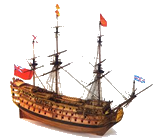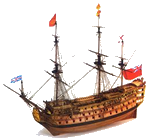Carronade
Carronade
From Wikipedia, the free encyclopedia
68-pounder British naval carronade on HMS VictoryThe carronade was a short smoothbore, cast iron cannon, developed for the Royal Navy by the Carron Company, an ironworks in Falkirk, Scotland, UK. It was used from the 1770s to the 1850s. Its main function was to serve as a powerful, short-range anti-ship and anti-crew weapon. While considered very successful early on, carronades eventually disappeared as long-range naval artillery led to fewer and fewer close-range engagements.
History
The carronade was designed as a short-range naval weapon with a low muzzle velocity. Its invention is variously ascribed to Lieutenant General Robert Melville in 1759, or to Charles Gascoigne, manager of the Carron Company from 1769 to 1779. In its early years the weapon was sometimes called a "mellvinade" or alternatively, a "gasconade".
Carronades initially became popular on British merchant ships during the American Revolutionary War. A lightweight gun that needed only a small gun crew and was devastating at short range was a weapon well suited to defending merchant ships against French and American Privateers.
The Royal Navy was initially reluctant to adopt the guns, mainly due to mistrust of the Carron Company, which had developed a reputation for incompetence and commercial sharp practice. Carronades were not even counted in numbering the guns of a ship. It was Lord Sandwich who eventually started mounting them in place of the light guns on the forecastle and quarterdeck of ships. They soon proved their effectiveness in battle. French gun foundries were unable to produce equivalents for twenty years, so carronades gave British warships a significant tactical advantage during the latter part of the 18th century.
The carronade was initially very successful and widely adopted, and a few experimental ships (for example, HMS Glatton and HMS Rainbow) were fitted with a carronade-only armament. Glatton, a Fourth-rate ship with 56 guns, had a more destructive broadside than HMS Victory, a First-rate ship with 100 guns. Although Glatton and Rainbow were both successful in battle, the carronade's lack of range against an opponent who could keep well clear and still use his long guns was an arguable tactical disadvantage of this arrangement.
In the 1810s and 1820s tactics started to place a greater emphasis on the accuracy of long-range gunfire, and less on the weight of a broadside. Indeed, Captain David Porter of USS Essex complained when the Navy replaced his 12 pounder long guns with 32 pounder carronades. The carronade disappeared from the Royal Navy from the 1850s after the development of steel-jacketed cannon by William George Armstrong and Joseph Whitworth. Carronades were nevertheless still used in the American Civil War in the 1860s.
Design
Carronades had a chamber one calibre smaller than the bore – eg, an 18 pdr carronade had its chamber bored equal to a 12 pdr. This was partly to reduce weight of the cannon, but also had the effect of reducing the velocity of the cannonball and range to which it could fire, relative to a gun firing the same weight of shot, and all other things being equal. However, one factor mitigating the range issue is that carronades were bored with a much tighter windage than long guns. This meant that more of the propellant went to moving the shot, rather than bypassing it.
Furthermore, naval artillery during the Age of Sail simply was not accurate, regardless of whether the cannon was a gun or a carronade. Barrels were smooth bore, not rifled; tolerances on everything from shot, bores (windage), and sights were loose; and consequently there did not exist the fire control equipment and range tables that would enable gunners to fire competently at distant targets. The navy, to an even greater degree than the Army's infantry (where there were rifles), counted on the effect of massed fire at short range.
The lower muzzle velocity of a carronade's round shot was intended to create many more of the deadly wooden splinters when hitting the structure of an enemy vessel, leading to its nickname, the smasher[citation needed]. However, the short barrel also increased the risk that a carronade would eject burning wadding onto nearby combustible materials, increasing the risk of fire.
Ordnance
Diagram of a carronade mounting
Model of a carronade with grapeshot ammunitionA carronade was much shorter and a third to a quarter of the weight of an equivalent long gun: a 32 pounder carronade, for example, weighed less than a ton, but a 32 pounder long gun weighed over 3 tons. Carronades were manufactured in the usual naval gun calibres: 6, 12, 18, 24, 32 and 42 pounders, and 68 pdr versions are known.
The smaller carronades served in three roles. First, they often constituted the entire armament of unrated vessels. For instance, the Ballahou and Cuckoo class schooners were armed only with four 12-pounder carronades. Second, gunboats, such as those that the Americans deployed at the Battle of Lake Borgne often had one large 18, 24 or 32-pounder gun forward on a pivot, and two smaller carronades aft. Lastly, larger vessels carried a few 12, 18 or 24 pounders, to arm their ship's boats - the cutters, pinnaces, launches, barges, and the like - to give them firepower for boat actions. For instance, each of the 42 larger British boats at the Battle of Lake Borgne carried a carronade in its bows; only the three gigs were unarmed.
At the other end, even a quite small vessel might carry the 68-pounders. For instance, Cmdr. William Layman of the ill-fated Cruizer class brig sloop Raven replaced her two forward 6-pounder guns and 32-pounder carronades with a single 68-pounder on a pivot, and then did the same with two of the aft 32-pounder carronades. By doing this he replaced 70 pounds of broadside with 136 pounds (assuming that both 68-pounders would usually fire on the same side), and ensured that Raven would have less dead-space to her front and rear.
Carronades were not counted in a ship of the line's rated number of guns. The classification of Royal Navy vessels in this period can therefore mislead; they would often be carrying fewer guns but more pieces of ordnance than they were described as carrying.
Although the carronade, like other naval guns, was mounted with ropes to restrain the recoil, the details of the gun mounting were usually quite different. The carronade was typically mounted on a sliding, rather than wheeled, gun carriage, and elevation was achieved with a turnscrew, like field guns, rather than the quoins (wooden wedges) usual for naval guns. In addition, a carronade was usually mounted on a lug underneath the barrel, rather than the usual trunnions to either side. As a result, the carronade had an unusually high centre of gravity. Towards the end of the period of use, some carronades were fitted with trunnions to lower their centre of gravity, to create a variant known as the gunnade.
Range
As a result of irregularities in the size of cannon balls and the difficulty of boring out gun barrels, there was usually a considerable gap (known as the windage) between the ball and the inside of the gun barrel. The windage of a cannon was often as much as a quarter of an inch and caused a considerable loss of projectile power. The manufacturing practices introduced by the Carron Company reduced the windage considerably. Despite the reduced windage, carronades had a much shorter range, typically a third to a half, than the equivalent long gun because they used a much smaller propellant charge (the chamber for the powder was smaller than the bore for the ball). Typical naval tactics in the late 18th century, however, emphasised short-range broadsides, so the range was not thought to be a problem: indeed, their much lighter weight allowed a ship to carry more carronades, or carronades of a larger calibre, than long guns, and carronades could be mounted on the upper decks, where heavy long guns could cause the ship to be top-heavy and unstable. Carronades also required a smaller gun crew, and were faster to reload and easier to aim. HMS Victory used the two 68-pounder carronades which she carried on her forecastle to great effect at the Battle of Trafalgar, clearing the gun deck of the Bucentaure by firing a round shot and a keg of 500 musket balls through the Bucentaure's stern windows.
Picture key
1 Bolt Culasse
2 Aft sight
3 Vent hole
4 Front sight
5 First reinforce ring
6 Barrel Fut
7 Muzzle
8 Second reinforce ring
9 Horizontal rotation axis
10 Chock
11 Vertical rotation axis
12 Wheel
13 Mobile pedestal
14 Carriage
15 Pommel
16 Elevation thread




